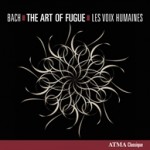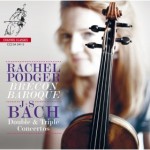
We don’t sing like robots, but accept that a violin or a piano can be played with mechanical precision. I scratch my head at how 20th century audiences accepted the latter in the performance of the music of J.S. Bach, more so when I hear alternatives in three new albums that open aural doors to finer seduction.
- Classical Music 101: What Does A Conductor Do? - June 17, 2019
- Classical Music 101 | What Does Period Instrument Mean? - May 6, 2019
- CLASSICAL MUSIC 101 | What Does It Mean To Be In Tune? - April 23, 2019
This richer spectrum of expressive possibility is laid out neatly by Montreal’s Voix Humaines, British violinist Rachel Podger and her Brecon Baroque ensemble, and violinist Viktoria Mullova and Italy’s Accademia Bizantina, all relying on historically informed techniques and period instruments.
 We speak of period performance as a single category, but it represents a mindset, not a fixed formula. For some, the mindset means a strict adherence to rules. For others, period performance is an excuse to indulge in all sorts of fantastical meanderings.
We speak of period performance as a single category, but it represents a mindset, not a fixed formula. For some, the mindset means a strict adherence to rules. For others, period performance is an excuse to indulge in all sorts of fantastical meanderings.
For me, true enchantment comes from Les Voix Humaines and their foundation-cracking, world-upturning take on The Art of the Fugue.
 Podger & co. are transparent grace and elegance, while Mullova & co. represent how much one can achieve even in the most rigorously modern-minded of approaches — both drawing from the concerto repertoire, with an overlap in the C minor Concerto for Violin and Oboe (BWV 1060), which appears in its later form for violin and harpsichord on Mullova’s disc.
Podger & co. are transparent grace and elegance, while Mullova & co. represent how much one can achieve even in the most rigorously modern-minded of approaches — both drawing from the concerto repertoire, with an overlap in the C minor Concerto for Violin and Oboe (BWV 1060), which appears in its later form for violin and harpsichord on Mullova’s disc.
 In all three instances, the musicians treat Bach’s music as if it were being sung — with a clear sense of phrasing, of dialogue, of breath, of slight alterations in tempo. It is music animated by a beating human heart, with its constant changes of speed and rhythm, rather than a strict mechanical timekeeper.
In all three instances, the musicians treat Bach’s music as if it were being sung — with a clear sense of phrasing, of dialogue, of breath, of slight alterations in tempo. It is music animated by a beating human heart, with its constant changes of speed and rhythm, rather than a strict mechanical timekeeper.
Off the spectrum in radicalness is the work of Les Voix Humaines: viola da gamba players Susie Napper and Margaret Little, augmented by Mélisande Corriveau and Torontonian Felix Deak. This album was released by Montreal’s ATMA Classique.
From the opening measures, where Bach lays out the short musical theme that he would use and reuse in the 20 fugues and canons in his unfinished compositional last will and testament, The Art of the Fugue, we are transported to a new-old world.
Napper and her quartet are playing on viols, instruments that were pretty much obsolete by the time Bach wrote this music. But the sweet, mellow contours of sound the viols produce is, as the group’s name suggests, very much like the human voice. And these four players make no apologies for adding all sorts of nuance to each sequence of notes.
Bach never specified instrumentation for the Art of the Fugue. We don’t even know if his exercises were meant to be more than technical examples of his prowess, laid out carefully for the envy of future would-be composers.
We usually hear the music done with the same rigorous mathematical precision that informed Bach’s ingenious modulations and inversions. But the Voix Humaines treat everything they see as pure dialogue across the wide, rich range of timbres that run from the high pardessus de viole to the bass viol.
The result at once is historically informed while tossing history and tradition out the window, declaring that this is something completely different and equally valid.
The album sits in my most prized personal-listening shelf, and should be offered up to anyone who has any doubts that Bach, the indescribable genius on paper, was a real, flesh-and-blood human being with music to match.
You can find all the details on this album here.
Rachel Podger, who made such an impressive Toronto début with Tafelmusik at the start of this past season, brings her special light and grace to Bach’s well-loved double and triple concertos. One of the things that makes this album special is how the ripieno parts (the members of the orchestra backing up the soloists) are also played by single instruments, giving the sound a beguiling lightness and transparency.
Podger’s band is Brecon Baroque, her own, hand-picked consort of soloists, who play as is possessed of one mind yet conscious of the need to express each part as a unique conversation in a larger theatrical-musical conversation.
You can find all the details on this Channel Classics album here. And this is a backgrounder video:
Much more conventional, yet no less worthy of attention is the collaboration between Viktoria Mullova and the Accademia Bizantina under its leader Ottavio Dantone.
The four concertos here are very nicely played with much brio, but the overall interpretations are, despite their dynamic range, quite buttoned down conversationally. This is period performance for people who think they prefer modern instruments and interpretations.
You’ll find the details on this Onyx album (with a really unfortunate cover photograph) here.
+++
To show a range of what Voix Humaines does with music, here are some highlights from a 2012 summer festival performance from the Montreal area, featuring soprano Suzie Leblanc, who sends us on our way with a beguiling reading of “Summertime” from Porgy & Bess:
John Terauds
- Classical Music 101: What Does A Conductor Do? - June 17, 2019
- Classical Music 101 | What Does Period Instrument Mean? - May 6, 2019
- CLASSICAL MUSIC 101 | What Does It Mean To Be In Tune? - April 23, 2019



